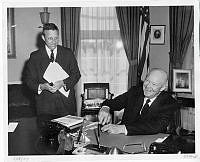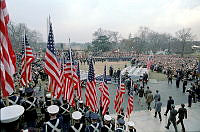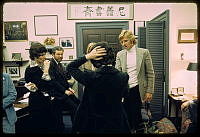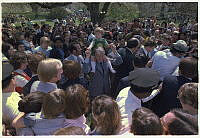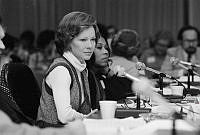Rubenstein Center Scholarship
The "Sunshine Special"
The Presidential Cars of Franklin D. Roosevelt

President Franklin Roosevelt and his Scottish Terrier, Fala, enjoy a drive near Hyde Park, New York.
Library of CongressDuring Franklin Roosevelt’s twelve years as president, cars were a source of transportation, visibility, protection, and even amusement. When he contracted polio in 1921 at the age of 39, he had lost almost all use of his legs, meaning that he was no longer able to drive a car.1 As a result, Roosevelt had his private automobiles outfitted with special hand controls that allowed him to drive without his legs. He owned a 1938 Ford Convertible Coupe and a 1936 Ford Phaeton for personal use at his home in Hyde Park, New York, or when he was visiting the “Little White House” in Warm Springs, Georgia.2 He loved to drive on back country roads with the top down on his convertibles.
Roosevelt made many additions to the White House fleet of automobiles during his time in office. Reportedly there were 25 cars in the fleet at the end of Herbert Hoover’s administration and this number increased during the Roosevelt administration.3 Some of these cars were well known and widely photographed while others were not. It is known that during Roosevelt’s first term, a 1935 Packard seven-passenger vehicle was added to the White House fleet. After Roosevelt was inaugurated for his second term in 1937, the government accepted bids from the Ford Motor Company, General Motors, and Packard Motors for additional vehicles built to the high standards of the Secret Service.4
As a result of these bids, a pair of 1938 V16 Cadillacs were leased from General Motors. These vehicles were semi-armored and weighed approximately 8,000 pounds. Although they were intended to carry President Roosevelt, he preferred to use the 1935 Packard probably because it was larger and allowed the disabled president more room to maneuver.5 The Cadillacs were primarily used by the Secret Service and were nicknamed, “Queen Mary” and “Queen Elizabeth” after the luxury ocean liners. According to one 1950 Washington Evening Star article, the cars may have been named by Roosevelt himself after he compared riding in them to traveling on the Queen Mary.6 In 1939 the White House leased a new seven-passenger limousine from Packard. However, the narrow doors on this vehicle made it difficult for Roosevelt to climb into the car.7 Because these new cars were not very accessible for the president, a new vehicle was commissioned with his physical limitations specifically in mind.

President-elect Roosevelt exiting St. John's Church on the morning of his inauguration, March 4, 1933.
Library of CongressThe result was Roosevelt’s most famous automobile—a 1939 Lincoln K series limousine leased from the Ford Motor Company and affectionately nicknamed, “Sunshine Special.” This vehicle was the first specifically designed and modified for use by the president.8 It was built with wider rear doors for better maneuverability, forward-facing jump seats, step plates, handles for Secret Service agents, and even featured a police light and siren system. It was also a convertible, which allowed Roosevelt to remain visible to the crowds. This car quickly became Roosevelt’s favorite because it projected the formality of a presidential vehicle, permitted spectators to see their leader, and was quite comfortable.9
Although it provided visibility, formality, and comfort, the “Sunshine Special” lacked security. When the United States was attacked at Pearl Harbor on December 7, 1941 the Secret Service realized that all vehicles would require far greater protective measures and sought to acquire a vehicle that would provide this additional security. A rumor circulated about the car designated to replace the “Sunshine Special” while it was returned to the factory for modifications. A book written by Secret Service Agent Michael F. Reilly alleged a car with a “dubious reputation” was used to transport Roosevelt from the White House to the United States Capitol for the announcement of the declaration of war on December 8.10 According to Reilly, the president used a car the Treasury Department had seized from legendary Chicago mob boss, Al Capone. It remains unclear why Reilly made these statements. There is no evidence to support this claim, although it has been widely reported and repeated over time. Photographs from December 8 depict Roosevelt riding in one of the semi-armored 1938 Cadillacs, which dispels the fascinating yet spurious story.

President Herbert Hoover and President-elect Franklin Roosevelt prepare to leave the White House for the Capitol on March 4, 1933.
Library of Congress
When the “Sunshine Special” came back from the factory after its overhaul and upgrade, it boasted a number of new features. It was equipped with bulletproof glass, steel armor, a gun case, a radio system, and special rear bumpers as a place for the Secret Service to stand. The government also commissioned a brand-new armored 1942 Lincoln H-series limousine and retrofitted the rest of the existing cars in the fleet with armor and bulletproof glass.11 At this point the “Sunshine Special” and its counterparts were fully equipped to provide the comfort, visibility, and security Roosevelt required during the war. He continued to use these vehicles throughout the remainder of his presidency. The Special and the Queens also conveyed President Harry Truman until 1950 when they were retired from service.12 The “Sunshine Special” was shipped to Dearborn, Michigan to be housed in The Edison Institute, later renamed The Henry Ford Museum of American Innovation.13 Today it is on display at The Henry Ford Museum, along with a number of other presidential vehicles.

This black and white photograph shows President Franklin Roosevelt and First Lady Eleanor Roosevelt arriving at the Lincoln Memorial for a February 1943 ceremony celebrating Lincoln's birthday.
Franklin D. Roosevelt Presidential Library and Museum/NARANo matter what the occasion, official or recreational, President Franklin Roosevelt always had a top-of the-line vehicle at his disposal. His presidential fleet was specially designed for his comfort and security and his personal cars were outfitted for drives through the backroads of Georgia or for a ride with his dog, Fala, in Hyde Park. For a man that traveled around the world, having reliable transportation was essential.

This is President Franklin Roosevelt's 1939 Lincoln K limousine that he nicknamed "The Sunshine Special." Roosevelt called it so because of its convertible top, which he liked to put down so he could enjoy the sun.
Brody Levesque/Wikimedia Commons







